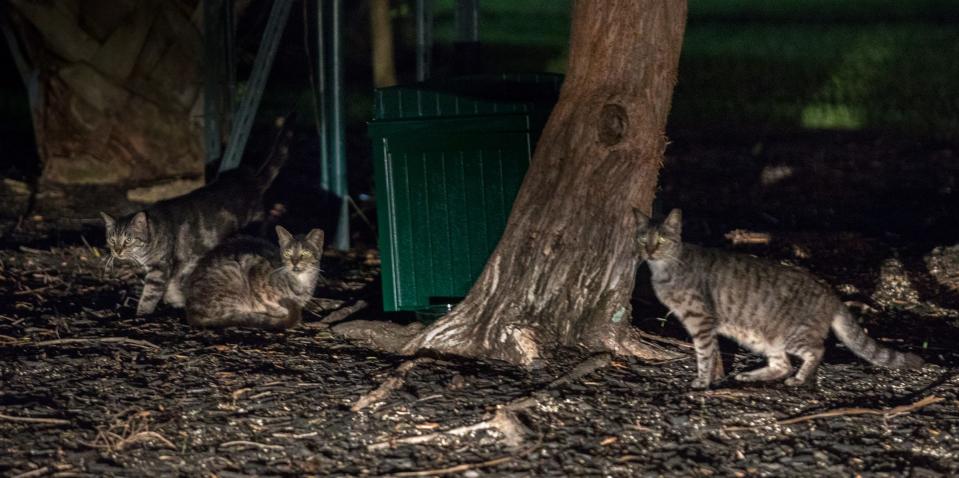Palm Beach cat population growing as more people abandon felines on island, group says
The population of feral cats in Palm Beach is growing — in part because of an increase of people abandoning their cats on the island.
That was the message from Palm Beach Island Cats President David Leavitt to the Town Council in his annual update during Tuesday's meeting.
Cats are being brought over the bridges and released, Leavitt said.
"We have 50% more counted cats this year," he told the council, saying the organization's census counted 350 cats in 2023, up from 230 the year before.
Palm Beach Island Cats was founded about 14 years ago to deal with a growing feral cat population that numbered above 1,000 and disrupted Palm Beachers' way of life, Leavitt said.
"We had cats on Worth Avenue," he said. "People leaving with bags from restaurants had cats trying to get the food."
"Palm Beach Island Cats wants all cats to live safely in houses," Leavitt said. "Our program of trap, neuter, return and maintain is the humane way to get there."
The cats were ill and often hungry, and they bred unabated, he said.
In terms of abandoned cats, Leavitt said the group was particularly struck by the number of single kittens — not entire litters — that were dumped in Palm Beach last year.
"The really weird thing is we had 28 single kittens dumped," he said. "Always, it's been litters. We have never seen single kittens dumped."
In addition to the 28 single kittens, the group in 2023 worked with 18 kittens in three litters that also were dumped, Leavitt said. That total of 46 kittens was up from 15 in 2022, he said. Of the 46 kittens, nine were returned to the island and 37 were placed for adoption, Leavitt said.

The abandoned cats pose more of a challenge than a typical feral cat because many of them have recently been trapped before being released on the island, so they are wary of traps and not easily captured again, Leavitt said.
He pointed to an issue on Jamaica Lane a few years ago as an example of how quickly the cat population can grow: "In short order, three cats became 46 cats," he said.
"We have learned that fertile cats will continue to be abandoned here, and a town TNR (trap and release) group will always be needed to ensure a huge cat population is not created again," Leavitt said.
The number of cats that were sterilized — spayed or neutered — with support from Palm Beach Island Cats nearly doubled, from 32 in 2022 to 57 cats last year, Leavitt said.
The organization has faced challenges in accomplishing its goal of sterilizing as many cats as possible, thanks to a population boom across the bridges in West Palm Beach that has overwhelmed nonprofits, he said. The demand has exceeded the capacity at providers including Peggy Adams Animal Rescue League near West Palm Beach, which does most of the spay and neuter procedures for Palm Beach Island Cats, Leavitt said.
While Peggy Adams' schedule has been booked, Island Cats was able to book two slots in the past week and a half, with five cats at each time, he said. "We never stopped trying to get in," Leavitt said. Still, he added, "We had 57 cats for us to alter this year and it was very difficult to accomplish."
Palm Beach Island Cats increased its number of feeding stations from 35 in 2022 to 50 in 2023, he said. The group fed cats more than 4,000 pounds of dry food and more than 21,000 cans of wet food last year, Leavitt said, adding that while that number was lower than 2022, some residents chose to buy their own cat food in 2023.
Leavitt shared a reminder for Palm Beach residents and visitors to always keep an eye on pets and never leave them unattended outside, because there are coyotes that roam the island.
In terms of successes over the past year, Leavitt highlighted the former cat colony that lived for decades around the Royal Poinciana Playhouse. The members of Island Cats were able to decrease the population slowly, he said, and when reconstruction of the playhouse began in 2023, no cats were left in the colony.
He thanked his board of directors and staff, who he said never miss a night or a feeding station. "Those are hard shoes to fill," he said.
He also thanked town officials for their support. "When we started, we couldn't raise the funds, and the town stepped in and helped us with the shortfall," Leavitt said.
Councilman Lew Crampton recalled that during his first run for the council, he had to have a position on feral cats. The cats were yowling and "marauding in packs" around the island, Crampton said.
"It was a serious, serious problem that was very visible to all of us," he said, adding, "Your report today indicates that a huge amount of unseen work is necessary" to continue controlling the feral cat population.
When council president Maggie Zeidman asked Leavitt what the group needs, Leavitt asked that the council "just continue your support."
"We're doing alright," Leavitt said. "The town residents are supporting us, and have for years now, so we're doing OK."
For more information or to donate to Palm Beach Island Cats, go to pbislandcats.org.
This article originally appeared on Palm Beach Daily News: Palm Beach cat population grows as people abandon felines on island

